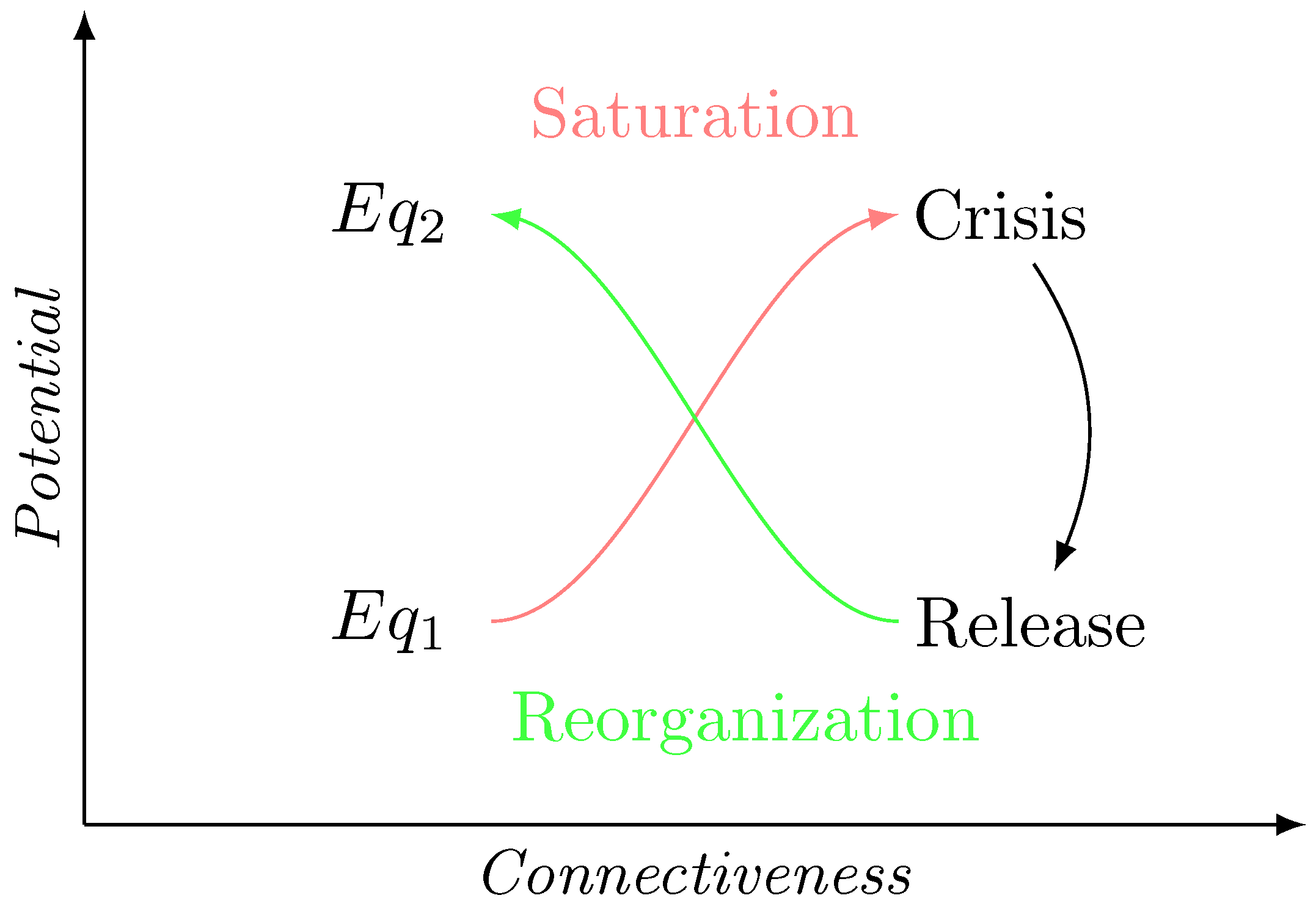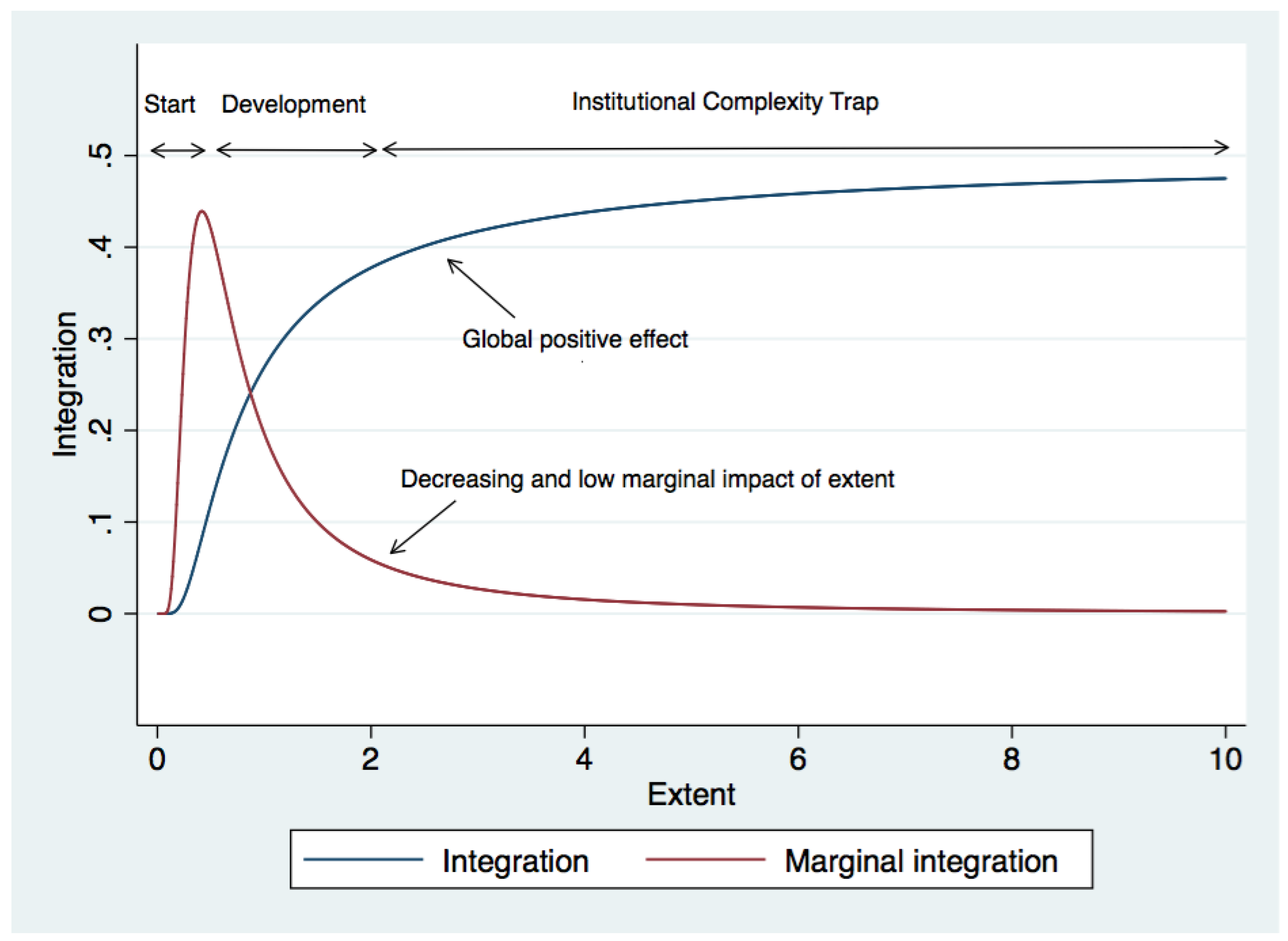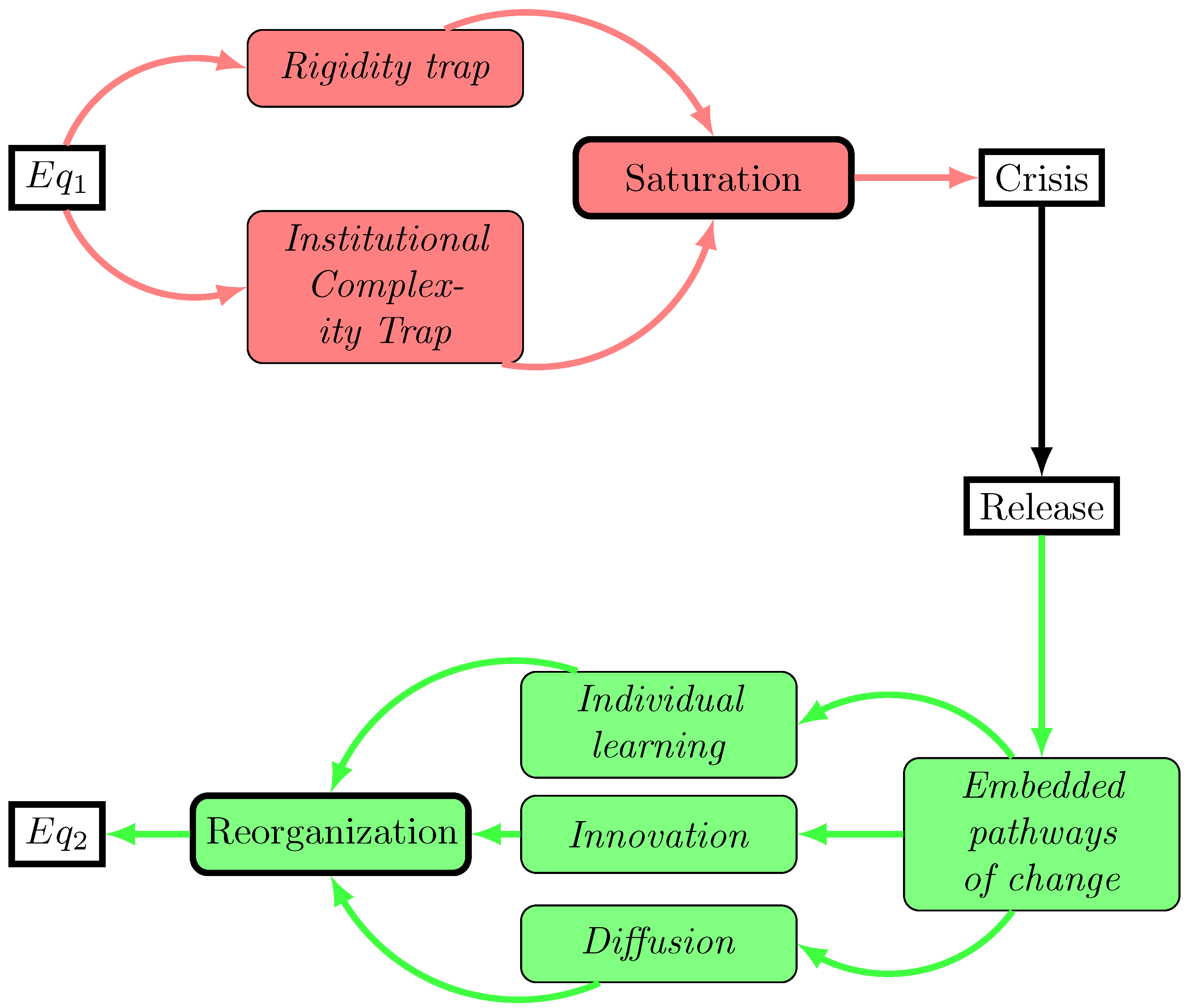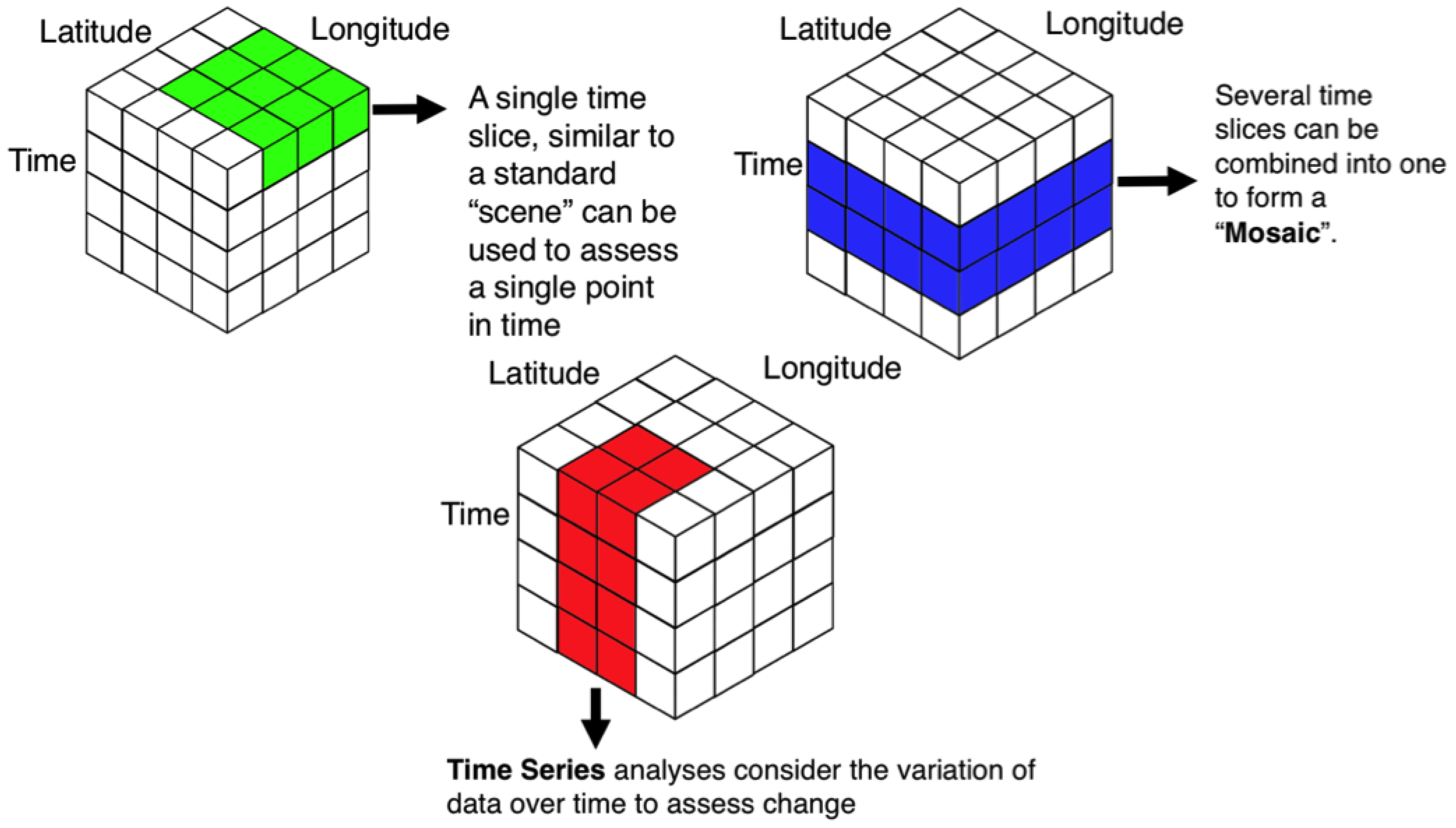Explaining and Measuring Social-Ecological Pathways: The Case of Global Changes and Water Security
Abstract
1. Introduction
2. Social-Ecological Systems and Evolution: Theoretical Framework
2.1. Social-Ecological Systems and Resilience: Origins and Scope
2.2. An Institutional and Cognitive Model of Change
2.2.1. Evolution through an Adaptive Cycle
2.2.2. Explaining the Saturation of a Social-Ecological System
2.2.3. Explaining the Reorganization of a Social-Ecological System
3. SES Evolution and Measurement: Insights from the Case of Water Security
3.1. Limitations to General Knowledge about Water Security: Measurement Heterogeneity and Time-Limited Analyses
3.2. Dealing with Measurement Disparity and Evolution: Recommendations to Reinforce External and Internal Validity
4. Earth Observations for Water Security: The Data Cube
4.1. Earth Observation Data to Consider the Spatial Dimension of Social-Ecological Systems and Water Security
4.2. The Data Cube to Make Earth-Observation-Based Research Replicable over Time and Space
4.3. Avenues for Implementing an Analysis of Water Security Dynamics through Data Cube
5. Conclusions and Next Steps
Author Contributions
Funding
Conflicts of Interest
Abbreviations
| ARD | Analysis Ready Data |
| EO | Earth Observation |
| EODC | Earth Observation Data Cube |
| IAD | Institutional And Development framework |
| IWRM | Integrated Water Resource Management |
| SES | Social-Ecological System |
References
- Costanza, R.; de Groot, R.; Braat, L.; Kubiszewski, I.; Fioramonti, L.; Sutton, P.; Farber, S.; Grasso, M. Twenty years of ecosystem services: How far have we come and how far do we still need to go? Ecosyst. Serv. 2017, 28, 1–16. [Google Scholar] [CrossRef]
- Bolognesi, T.; Kluser, S. Water security as a normative goal or as a structural principle for water governance. In A Critical Approach to International Water Management Trends: Policy and Practice; Palgrave Studies in Water Governance: Policy and Practice; Palgrave MacMillan: London, UK, 2018. [Google Scholar]
- Gerlak, A.K.; Mukhtarov, F. ‘Ways of knowing’ water: Integrated water resources management and water security as complementary discourses. Int. Environ. Agreements Polit. Law Econ. 2015, 15, 257–272. [Google Scholar] [CrossRef]
- Dadson, S.; Hall, J.W.; Garrick, D.; Sadoff, C.; Grey, D.; Whittington, D. Water security, risk, and economic growth: Insights from a dynamical systems model. Water Resour. Res. 2017, 53, 6425–6438. [Google Scholar] [CrossRef]
- Gain, A.K.; Giupponi, C.; Wada, Y. Measuring global water security towards sustainable development goals. Environ. Res. Lett. 2016, 11, 124015. [Google Scholar] [CrossRef]
- Lawford, R.; Strauch, A.; Toll, D.; Fekete, B.; Cripe, D. Earth observations for global water security. Curr. Opin. Environ. Sustain. 2013, 5, 633–643. [Google Scholar] [CrossRef]
- Scott, G.; Rajabifard, A. Sustainable development and geospatial information: A strategic framework for integrating a global policy agenda into national geospatial capabilities. Geo-Spat. Inf. Sci. 2017, 20, 59–76. [Google Scholar] [CrossRef]
- Ostrom, E. A General Framework for Analyzing Sustainability of Social-Ecological Systems. Science 2009, 325, 419–422. [Google Scholar] [CrossRef] [PubMed]
- McGinnis, M.D.; Ostrom, E. Social-ecological system framework: Initial changes and continuing challenges. Ecol. Soc. 2014, 19, 30. [Google Scholar] [CrossRef]
- Schlager, E.; Cox, M. The IAD Framework and the SES Framework: An Introduction and Assessment of the Ostrom Workshop Frameworks. In Theories of the Policy Process; Westview Press: New York, NY, USA, 2018; pp. 215–252. [Google Scholar] [CrossRef]
- Ratajczyk, E.; Brady, U.; Baggio, J.; Barnett, A.; Perez-Ibarra, I.; Rollins, N.; Rubiños, C.; Shin, H.; Yu, D.; Aggarwal, R.; et al. Challenges and opportunities in coding the commons: Problems, procedures, and potential solutions in large-N comparative case studies. Int. J. Commons 2016, 10. [Google Scholar] [CrossRef]
- Robinson, D.T.; Vittorio, A.D.; Alexander, P.; Arneth, A.; Barton, C.M.; Brown, D.G.; Kettner, A.; Lemmen, C.; O’Neill, B.C.; Janssen, M.; et al. Modelling feedbacks between human and natural processes in the land system. Earth Syst. Dyn. 2018, 9, 895–914. [Google Scholar] [CrossRef]
- Giuliani, G.; Chatenoux, B.; Bono, A.D.; Rodila, D.; Richard, J.P.; Allenbach, K.; Dao, H.; Peduzzi, P. Building an Earth Observations Data Cube: Lessons learned from the Swiss Data Cube (SDC) on generating Analysis Ready Data (ARD). Big Earth Data 2017, 1, 100–117. [Google Scholar] [CrossRef]
- Lewis, A.; Oliver, S.; Lymburner, L.; Evans, B.; Wyborn, L.; Mueller, N.; Raevksi, G.; Hooke, J.; Woodcock, R.; Sixsmith, J.; et al. The Australian Geoscience Data Cube—Foundations and lessons learned. Remote Sens. Environ. 2017, 202, 276–292. [Google Scholar] [CrossRef]
- Bolognesi, T. Modernization and Urban Water Governance: Organizational Change and Sustainability in Europe; Palgrave Macmillan UK: London, UK, 2018. [Google Scholar] [CrossRef]
- Vörösmarty, C.J.; McIntyre, P.B.; Gessner, M.O.; Dudgeon, D.; Prusevich, A.; Green, P.; Glidden, S.; Bunn, S.E.; Sullivan, C.A.; Liermann, C.R.; et al. Global threats to human water security and river biodiversity. Nature 2010, 467, 555–561. [Google Scholar] [CrossRef] [PubMed]
- Bolognesi, T. The water vulnerability of metro and megacities: An investigation of structural determinants. Nat. Resour. Forum 2015, 39, 123–133. [Google Scholar] [CrossRef]
- Flörke, M.; Schneider, C.; McDonald, R.I. Water competition between cities and agriculture driven by climate change and urban growth. Nat. Sustain. 2018, 1, 51–58. [Google Scholar] [CrossRef]
- Anderies, J.; Janssen, M.; Ostrom, E. A Framework to Analyze the Robustness of Social-ecological Systems from an Institutional Perspective. Ecol. Soc. 2004, 9. [Google Scholar] [CrossRef]
- Ostrom, E.; Janssen, M.A.; Anderies, J.M. Going beyond panaceas. Proc. Natl. Acad. Sci. USA 2007, 104, 15176–15178. [Google Scholar] [CrossRef] [PubMed]
- Cole, D.H.; Epstein, G.; McGinnis, M.D. Toward a New Institutional Analysis of Social-Ecological Systems (NIASES): Combining Elinor Ostrom’s IAD and SES Frameworks; Indiana Legal Studies Research Paper No. 299; Indiana University Bloomington: Bloomington, IN, USA, 2014. [Google Scholar]
- Ostrom, E.; Janssen, M.A. Multi-Level Governance and Resilience of Social-Ecological Systems. In Globalisation, Poverty and Conflict: A Critical “Development” Reader; Spoor, M., Ed.; Springer Netherlands: Dordrecht, The Netherlands, 2005; pp. 239–259. [Google Scholar] [CrossRef]
- Gunderson, L.H.; Holling, C.S. Panarchy Understanding Transformations in Human and Natural Systems; Island Press: Washington, DC, USA, 2002. [Google Scholar]
- Holling, C.S. Engineering resilience versus ecological resilience. In Engineering within Ecological Constraints; The National Academies Press: Washington, DC, USA, 1996; pp. 31–44. [Google Scholar]
- Holling, C.S. Resilience and Stability of Ecological Systems. Annu. Rev. Ecol. Syst. 1973, 4, 1–23. [Google Scholar] [CrossRef]
- Pimm, S.L. The complexity and stability of ecosystems. Nature 1984, 307, 321–326. [Google Scholar] [CrossRef]
- Fath, B.; Dean, C.; Katzmair, H. Navigating the adaptive cycle: An approach to managing the resilience of social systems. Ecol. Soc. 2015, 20. [Google Scholar] [CrossRef]
- Lubell, M.; Robins, G.; Wang, P. Network structure and institutional complexity in an ecology of water management games. Ecol. Soc. 2014, 19. [Google Scholar] [CrossRef]
- Stedman, R.C. Subjectivity and social-ecological systems: A rigidity trap (and sense of place as a way out). Sustain. Sci. 2016, 11, 891–901. [Google Scholar] [CrossRef]
- Bolognesi, T.; Nahrath, S. Environmental Governance Dynamics: Some Micro Foundations of Macro Failures. 2018. Available online: https://ssrn.com/abstract=3163828 (accessed on 22 November 2018).
- Bolognesi, T.; Nahrath, S.; Metz, F. Why Resource Regimes Fail in the Long Run? The Role of Institutional Complexity Traps and Transversal Transaction Costs; Social Science Research Network: Rochester, NY, USA, 2017. [Google Scholar]
- Renou, Y.; Bolognesi, T. Governing urban water services in Europe: Towards sustainable synchronous regimes. J. Hydrol. 2018. [Google Scholar] [CrossRef]
- Heikkila, T.; Gerlak, A.K. Working on learning: How the institutional rules of environmental governance matter. J. Environ. Plan. Manag. 2018, 1–18. [Google Scholar] [CrossRef]
- Pahl-Wostl, C. A conceptual framework for analysing adaptive capacity and multi-level learning processes in resource governance regimes. Glob. Environ. Chang. 2009, 19, 354–365. [Google Scholar] [CrossRef]
- Newig, J.; Kochskämper, E.; Challies, E.; Jager, N.W. Exploring governance learning: How policymakers draw on evidence, experience and intuition in designing participatory flood risk planning. Environ. Sci. Policy 2016, 55, 353–360. [Google Scholar] [CrossRef] [PubMed]
- Carpenter, S.; Brock, W. Adaptive Capacity and Traps. Ecol. Soc. 2008, 13. [Google Scholar] [CrossRef]
- Varone, F.; Nahrath, S. Regulating the use of natural resources: When policy instruments meet property rights. In L’Instrumentation de l’Action Publique. Controverses, Resistances, Effets; Presses de Sciences Po: Paris, France, 2014; pp. 237–264. [Google Scholar]
- Gerber, J.D.; Knoepfel, P.; Nahrath, S.; Varone, F. Institutional Resource Regimes: Towards sustainability through the combination of property-rights theory and policy analysis. Ecol. Econ. 2009, 68, 798–809. [Google Scholar] [CrossRef]
- Vatn, A. Institutions and the Environment; Edward Elgar Publishing: Cheltenham, UK, 2005. [Google Scholar]
- Banos-González, I.; Martínez-Fernández, J.; Esteve-Selma, M.A. Using dynamic sustainability indicators to assess environmental policy measures in Biosphere Reserves. Ecol. Indic. 2016, 67, 565–576. [Google Scholar] [CrossRef]
- Vidal-Legaz, B.; Martínez-Fernández, J.; Picón, A.S.; Pugnaire, F.I. Trade-offs between maintenance of ecosystem services and socio-economic development in rural mountainous communities in southern Spain: A dynamic simulation approach. J. Environ. Manag. 2013, 131, 280–297. [Google Scholar] [CrossRef] [PubMed]
- Cejudo, G.M.; Michel, C.L. Addressing fragmented government action: Coordination, coherence, and integration. Policy Sci. 2017, 50, 745–767. [Google Scholar] [CrossRef]
- Teisman, G.R.; Edelenbos, J. Towards a perspective of system synchronization in water governance: a synthesis of empirical lessons and complexity theories. Int. Rev. Adm. Sci. 2011, 77, 101–118. [Google Scholar] [CrossRef]
- Sarasvathy, S.D. Effectuation: Elements of Entrepreneurial Expertise; Edward Elgar Publishing: Cheltenham, UK, 2009. [Google Scholar]
- Adger, W.N.; Brown, K.; Tompkins, E.L. The Political Economy of Cross-Scale Networks in Resource Co-Management. Ecol. Soc. 2005, 10, 9. [Google Scholar] [CrossRef]
- Adger, W.N. Vulnerability. Glob. Environ. Chang. 2006, 16, 268–281. [Google Scholar] [CrossRef]
- Young, O.R. Institutional dynamics: Resilience, vulnerability and adaptation in environmental and resource regimes. Glob. Environ. Chang. 2010, 20, 378–385. [Google Scholar] [CrossRef]
- Miller, F.; Osbahr, H.; Boyd, E.; Thomalla, F.; Bharwani, S.; Ziervogel, G.; Walker, B.; Birkmann, J.; van der Leeuw, S.; Rockström, J.; et al. Resilience and Vulnerability: Complementary or Conflicting Concepts? Ecol. Soc. 2010, 15. [Google Scholar] [CrossRef]
- Heikkila, T.; Villamayor-Tomas, S.; Garrick, D. Special Issue: Bringing polycentric systems into focus for environmental governance. Environ. Policy Gov. 2018, 28, 207–318. [Google Scholar] [CrossRef]
- Pahl-Wostl, C.; Knieper, C. The capacity of water governance to deal with the climate change adaptation challenge: Using fuzzy set Qualitative Comparative Analysis to distinguish between polycentric, fragmented and centralized regimes. Glob. Environ. Chang. 2014, 29, 139–154. [Google Scholar] [CrossRef]
- da Silveira, A.R.; Richards, K.S. The Link Between Polycentrism and Adaptive Capacity in River Basin Governance Systems: Insights from the River Rhine and the Zhujiang (Pearl River) Basin. Ann. Assoc. Am. Geogr. 2013, 103, 319–329. [Google Scholar] [CrossRef]
- Folke, C.; Hahn, T.; Olsson, P.; Norberg, J. Adaptive Governance of Social-Ecological Systems. Annu. Rev. Environ. Resour. 2005, 30, 441–473. [Google Scholar] [CrossRef]
- Galaz, V.; Crona, B.; Österblom, H.; Olsson, P.; Folke, C. Polycentric systems and interacting planetary boundaries—Emerging governance of climate change–ocean acidification–marine biodiversity. Ecol. Econ. 2012, 81, 21–32. [Google Scholar] [CrossRef]
- Heikkila, T.; Gerlak, A.K. Building a Conceptual Approach to Collective Learning: Lessons for Public Policy Scholars. Policy Stud. J. 2013, 41, 484–512. [Google Scholar] [CrossRef]
- McCord, P.; Dell’Angelo, J.; Baldwin, E.; Evans, T. Polycentric Transformation in Kenyan Water Governance: A Dynamic Analysis of Institutional and Social-Ecological Change. Policy Stud. J. 2017, 45, 633–658. [Google Scholar] [CrossRef]
- Poteete, A.R.; Janssen, M.A.; Ostrom, E. Working Together: Collective Action, the Commons, and Multiple Methods in Practice; Princeton University Press: Princeton, NJ, USA, 2010. [Google Scholar]
- Ostrom, E.; Basurto, X. Crafting analytical tools to study institutional change. J. Inst. Econ. 2011, 7, 317–343. [Google Scholar] [CrossRef]
- Cleaver, F. Reinventing Institutions: Bricolage and the Social Embeddedness of Natural Resource Management. Eur. J. Dev. Res. 2002, 14, 11–30. [Google Scholar] [CrossRef]
- Cook, C.; Bakker, K. Water security: Debating an emerging paradigm. Glob. Environ. Chang. 2012, 22, 94–102. [Google Scholar] [CrossRef]
- Gerlak, A.K.; House-Peters, L.; Varady, R.G.; Albrecht, T.; Zúñiga-Terán, A.; de Grenade, R.R.; Cook, C.; Scott, C.A. Water security: A review of place-based research. Environ. Sci. Policy 2018, 82, 79–89. [Google Scholar] [CrossRef]
- Huai, C.; Chai, L. A bibliometric analysis on the performance and underlying dynamic patterns of water security research. Scientometrics 2016, 108, 1531–1551. [Google Scholar] [CrossRef]
- Wichelns, D. The water-energy-food nexus: Is the increasing attention warranted, from either a research or policy perspective? Environ. Sci. Policy 2017, 69, 113–123. [Google Scholar] [CrossRef]
- Al-Saidi, M.; Elagib, N.A. Towards understanding the integrative approach of the water, energy and food nexus. Sci. Total Environ. 2017, 574, 1131–1139. [Google Scholar] [CrossRef] [PubMed]
- Ostrom, E. Understanding Institutional Diversity; Princeton University Press: Princeton, NJ, USA, 2005. [Google Scholar]
- Heikkila, T.; Weible, C.M. A semiautomated approach to analyzing polycentricity. Environ. Policy Gov. 2018, 28, 308–318. [Google Scholar] [CrossRef]
- Leifeld, P. Reconceptualizing Major Policy Change in the Advocacy Coalition Framework: A Discourse Network Analysis of German Pension Politics. Policy Stud. J. 2013, 41, 169–198. [Google Scholar] [CrossRef]
- Cranmer, S.J.; Leifeld, P.; McClurg, S.D.; Rolfe, M. Navigating the Range of Statistical Tools for Inferential Network Analysis. Am. J. Polit. Sci. 2017, 61, 237–251. [Google Scholar] [CrossRef]
- Vogt, J.M.; Epstein, G.B.; Mincey, S.K.; Fischer, B.C.; McCord, P. Putting the “E” in SES: Unpacking the ecology in the Ostrom social-ecological system framework. Ecol. Soc. 2015, 20, 55. [Google Scholar] [CrossRef]
- Janssen, M.A.; Anderies, J.M.; Ostrom, E. Robustness of Social-Ecological Systems to Spatial and Temporal Variability. Soc. Nat. Resour. 2007, 20, 307–322. [Google Scholar] [CrossRef]
- Epstein, G.; Pittman, J.; Alexander, S.M.; Berdej, S.; Dyck, T.; Kreitmair, U.; Rathwell, K.J.; Villamayor-Tomas, S.; Vogt, J.; Armitage, D. Institutional fit and the sustainability of social–ecological systems. Curr. Opin. Environ. Sustain. 2015, 14, 34–40. [Google Scholar] [CrossRef]
- Epstein, G.; Vogt, J.M.; Mincey, S.K.; Cox, M.; Fischer, B. Missing ecology: Integrating ecological perspectives with the social-ecological system framework. Int. J. Commons 2013, 7, 432–453. [Google Scholar] [CrossRef]
- Lehmann, A.; Giuliani, G.; Ray, N.; Rahman, K.; Abbaspour, K.C.; Nativi, S.; Craglia, M.; Cripe, D.; Quevauviller, P.; Beniston, M. Reviewing innovative Earth observation solutions for filling science-policy gaps in hydrology. J. Hydrol. 2014, 518, 267–277. [Google Scholar] [CrossRef]
- Concha, J.A.; Schott, J.R. Retrieval of color producing agents in Case 2 waters using Landsat 8. Remote Sens. Environ. 2016, 185, 95–107. [Google Scholar] [CrossRef]
- Ingold, K.; Moser, A.; Metz, F.; Herzog, L.; Bader, H.P.; Scheidegger, R.; Stamm, C. Misfit between physical affectedness and regulatory embeddedness: The case of drinking water supply along the Rhine River. Glob. Environ. Chang. 2018, 48, 136–150. [Google Scholar] [CrossRef]
- Giuliani, G.; Dao, H.; De Bono, A.; Chatenoux, B.; Allenbach, K.; De Laborie, P.; Rodila, D.; Alexandris, N.; Peduzzi, P. Live Monitoring of Earth Surface (LiMES): A framework for monitoring environmental changes from Earth Observations. Remote Sens. Environ. 2017, 202, 222–233. [Google Scholar] [CrossRef]
- Purss, M.B.J.; Lewis, A.; Oliver, S.; Ip, A.; Sixsmith, J.; Evans, B.; Edberg, R.; Frankish, G.; Hurst, L.; Chan, T. Unlocking the Australian Landsat Archive—From dark data to High Performance Data infrastructures. GeoResJ 2015, 6, 135–140. [Google Scholar] [CrossRef]
- Lehmann, A.; Chaplin-Kramer, R.; Lacayo, M.; Giuliani, G.; Thau, D.; Koy, K.; Goldberg, G. Lifting the Information Barriers to Address Sustainability Challenges with Data from Physical Geography and Earth Observation. Sustainability 2017, 9, 858. [Google Scholar] [CrossRef]
- Baumann, P.; Mazzetti, P.; Ungar, J.; Barbera, R.; Barboni, D.; Beccati, A.; Bigagli, L.; Boldrini, E.; Bruno, R.; Calanducci, A.; et al. Big Data Analytics for Earth Sciences: The EarthServer approach. Int. J. Digit. Earth 2016, 9, 3–29. [Google Scholar] [CrossRef]
- Gorelick, N.; Hancher, M.; Dixon, M.; Ilyushchenko, S.; Thau, D.; Moore, R. Google Earth Engine: Planetary-scale geospatial analysis for everyone. Remote Sens. Environ. 2017, 202, 18–27. [Google Scholar] [CrossRef]
- Maciel, A.M.; Camara, G.; Vinhas, L.; Picoli, M.C.A.; Begotti, R.A.; de Assis, L.F.F.G. A spatiotemporal calculus for reasoning about land-use trajectories. Int. J. Geogr. Inf. Sci. 2018, 33, 1–17. [Google Scholar] [CrossRef]
- Wulder, M.A.; Masek, J.G.; Cohen, W.B.; Loveland, T.R.; Woodcock, C.E. Opening the archive: How free data has enabled the science and monitoring promise of Landsat. Remote Sens. Environ. 2012, 122, 2–10. [Google Scholar] [CrossRef]
- Tulbure, M.G.; Broich, M.; Stehman, S.V.; Kommareddy, A. Surface water extent dynamics from three decades of seasonally continuous Landsat time series at subcontinental scale in a semi-arid region. Remote Sens. Environ. 2016, 178, 142–157. [Google Scholar] [CrossRef]
- Pasquarella, V.J.; Holden, C.E.; Kaufman, L.; Woodcock, C.E. From imagery to ecology: Leveraging time series of all available Landsat observations to map and monitor ecosystem state and dynamics. Remote Sens. Ecol. Conserv. 2016, 2, 152–170. [Google Scholar] [CrossRef]
- ESA. Sentinel Data Access Report 2016; Technical Report; European Space Agency: Paris, France, 2017. [Google Scholar]
- Malenovský, Z.; Rott, H.; Cihlar, J.; Schaepman, M.E.; García-Santos, G.; Fernandes, R.; Berger, M. Sentinels for science: Potential of Sentinel-1, -2, and -3 missions for scientific observations of ocean, cryosphere, and land. Remote Sens. Environ. 2012, 120, 91–101. [Google Scholar] [CrossRef]
- Dhu, T.; Dunn, B.; Lewis, B.; Lymburner, L.; Mueller, N.; Telfer, E.; Lewis, A.; McIntyre, A.; Minchin, S.; Phillips, C. Digital earth Australia—Unlocking new value from earth observation data. Big Earth Data 2017, 1, 64–74. [Google Scholar] [CrossRef]
- Anderson, K.; Ryan, B.; Sonntag, W.; Kavvada, A.; Friedl, L. Earth observation in service of the 2030 Agenda for Sustainable Development. Geo-Spat. Inf. Sci. 2017, 20, 77–96. [Google Scholar] [CrossRef]
- Killough, B. Open Data Cubes, a Big Data Solution for Global Capacity Building. 2018. Available online: https://www.unige.ch/actualites/archives/2018/sdc/ (accessed on 22 November 2018).
- Lewis, A.; Lymburner, L.; Purss, M.B.J.; Brooke, B.; Evans, B.; Ip, A.; Dekker, A.G.; Irons, J.R.; Minchin, S.; Mueller, N.; et al. Rapid, high-resolution detection of environmental change over continental scales from satellite data—The Earth Observation Data Cube. Int. J. Digit. Earth 2016, 9, 106–111. [Google Scholar] [CrossRef]
- Giuliani, G.; Peduzzi, P. The PREVIEW Global Risk Data Platform: A geoportal to serve and share global data on risk to natural hazards. Nat. Hazards Earth Syst. Sci. 2011, 11, 53–66. [Google Scholar] [CrossRef]
- Peduzzi, P. Flooding: Prioritizing protection? Nat. Clim. Chang. 2017, 7, 625–626. [Google Scholar] [CrossRef]
- Bergsma, E. Expert-influence in adapting flood governance: An institutional analysis of the spatial turns in the United States and the Netherlands. J. Inst. Econ. 2018, 14, 449–471. [Google Scholar] [CrossRef]




| Autopoietic Cohesion | Dissipative Cohesion | |
|---|---|---|
| Extension by control | Integrative synchronous regime | Entrepreneurial synchronous regime |
| Logic of action: integration | Logic of action: effectuation | |
| Structuring principle: integrity | Structuring principle: subsidiarity | |
| Extension by self-determination | Resilient synchronous regime | Transformative synchronous regime |
| Logic of action: resilience | Logic of action: transformation | |
| Structuring principle: adaptability | Structuring principle: reflexivity |
| Security Criteria (Weights) | Indicators (Weights) | Spatial and Temporal Scales |
|---|---|---|
| Availability (45%) | Water scarcity index (70%) | 0.5° spatial resolution; |
| Monthly mean value of 2010 | ||
| Drought index (15%) | 0.5° spatial resolution; | |
| Monthly mean value of 2012 | ||
| Groundwater depletion (15%) | 0.5° spatial resolution; | |
| Monthly mean value of 2010 | ||
| Accessibility to water services (20%) | Access to sanitation (40%) | Country scale; 2014 |
| Access to drinking water (60%) | Country scale; 2014 | |
| Safety and quality (20%) | Water quality index (50%) | Country scale; 2012 |
| Global flood frequency (50%) | Country scale; 1985–2003 | |
| Management (15%) | World governance index (70%) | Country scale; 2010 |
| Transboundary legal framework (15%) | River Basin scale; 2015 | |
| Transboundary political tension (15%) | River Basin scale; 2015 |
© 2018 by the authors. Licensee MDPI, Basel, Switzerland. This article is an open access article distributed under the terms and conditions of the Creative Commons Attribution (CC BY) license (http://creativecommons.org/licenses/by/4.0/).
Share and Cite
Bolognesi, T.; Gerlak, A.K.; Giuliani, G. Explaining and Measuring Social-Ecological Pathways: The Case of Global Changes and Water Security. Sustainability 2018, 10, 4378. https://doi.org/10.3390/su10124378
Bolognesi T, Gerlak AK, Giuliani G. Explaining and Measuring Social-Ecological Pathways: The Case of Global Changes and Water Security. Sustainability. 2018; 10(12):4378. https://doi.org/10.3390/su10124378
Chicago/Turabian StyleBolognesi, Thomas, Andrea K. Gerlak, and Gregory Giuliani. 2018. "Explaining and Measuring Social-Ecological Pathways: The Case of Global Changes and Water Security" Sustainability 10, no. 12: 4378. https://doi.org/10.3390/su10124378
APA StyleBolognesi, T., Gerlak, A. K., & Giuliani, G. (2018). Explaining and Measuring Social-Ecological Pathways: The Case of Global Changes and Water Security. Sustainability, 10(12), 4378. https://doi.org/10.3390/su10124378






